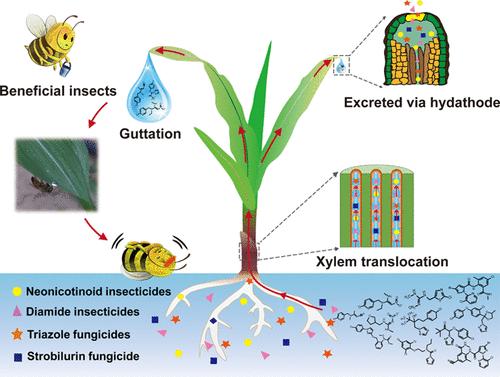当前位置:
X-MOL 学术
›
Environ. Sci. Technol.
›
论文详情
Our official English website, www.x-mol.net, welcomes your feedback! (Note: you will need to create a separate account there.)
From Water to Water: Insight into the Translocation of Pesticides from Plant Rhizosphere Solution to Leaf Guttation and the Associated Ecological Risks
Environmental Science & Technology ( IF 11.4 ) Pub Date : 2024-04-17 , DOI: 10.1021/acs.est.3c10925 Beiqi Xia 1 , Sijia Wang 1 , Runan Li 1 , Fengshou Dong 1 , Yongquan Zheng 2 , Yuanbo Li 1
Environmental Science & Technology ( IF 11.4 ) Pub Date : 2024-04-17 , DOI: 10.1021/acs.est.3c10925 Beiqi Xia 1 , Sijia Wang 1 , Runan Li 1 , Fengshou Dong 1 , Yongquan Zheng 2 , Yuanbo Li 1
Affiliation

|
Plant guttation is an important source of water/nutrients for many beneficial insects, while the presence of pesticides in guttation has been considered as a new exposure route for nontarget insects. This study aimed to elucidate how 15 diverse pesticides are translocated from growth media to guttation by maize plants through a hydroponic experiment. All pesticides were effectively translocated from the growth solution to maize guttation and reached a steady state within 5 days. The strong positive correlation (R2 = 0.43–0.84) between the concentrations of pesticides in guttation and in xylem sap demonstrated that xylem sap was a major source of pesticides in guttation. The relationship between the bioaccumulation of pesticides in guttation (BCFguttation) and the chemical Kow was split into two distinct patterns: for pesticides with log Kow > 3, we identified a good negative linear correlation between log BCFguttation and log Kow (R2 = 0.71); however, for pesticides with log Kow < 3, all data fall close to a horizontal line of BCFguttation ≅ 1, indicating that hydrophilic pesticides can easily pass through the plants from rhizosphere solution to leaf guttation and reach saturation status. Besides, after feeding with pesticide-contaminated guttation, the mortality of honeybees was significantly impacted, even at very low levels (e.g., ∑600 μg/L with a mortality of 93%). Our results provide essential information for predicting the contamination of plant guttation with pesticides and associated ecological risks.
中文翻译:

从水到水:深入了解农药从植物根际溶液到叶汁的迁移以及相关的生态风险
植物内脏是许多有益昆虫的重要水/养分来源,而内脏中农药的存在被认为是非目标昆虫的新暴露途径。本研究旨在阐明 15 种不同的农药如何通过水培实验从生长介质转移到玉米植株的内脏中。所有农药均有效地从生长溶液转移到玉米内脏中,并在 5 天内达到稳定状态。滴液中农药浓度与木质部汁液中农药浓度之间存在强正相关性(R 2 = 0.43–0.84),表明木质部汁液是滴液中农药的主要来源。农药的生物累积量 (BCF guttation ) 与化学K ow之间的关系分为两种不同的模式:对于 log K ow > 3 的农药,我们发现 log BCF guttation和 log K ow之间存在良好的负线性相关性(R 2 = 0.71);然而,对于log K ow < 3的农药,所有数据都落在BCF排泄≅1的水平线附近,这表明亲水性农药很容易从根际溶液穿过植物到达叶片排泄并达到饱和状态。此外,饲喂受农药污染的内脏后,蜜蜂的死亡率受到显着影响,即使是在非常低的水平(例如,Σ600μg/L,死亡率为93%)。我们的结果为预测农药对植物内脏的污染和相关的生态风险提供了重要信息。
更新日期:2024-04-17
中文翻译:

从水到水:深入了解农药从植物根际溶液到叶汁的迁移以及相关的生态风险
植物内脏是许多有益昆虫的重要水/养分来源,而内脏中农药的存在被认为是非目标昆虫的新暴露途径。本研究旨在阐明 15 种不同的农药如何通过水培实验从生长介质转移到玉米植株的内脏中。所有农药均有效地从生长溶液转移到玉米内脏中,并在 5 天内达到稳定状态。滴液中农药浓度与木质部汁液中农药浓度之间存在强正相关性(R 2 = 0.43–0.84),表明木质部汁液是滴液中农药的主要来源。农药的生物累积量 (BCF guttation ) 与化学K ow之间的关系分为两种不同的模式:对于 log K ow > 3 的农药,我们发现 log BCF guttation和 log K ow之间存在良好的负线性相关性(R 2 = 0.71);然而,对于log K ow < 3的农药,所有数据都落在BCF排泄≅1的水平线附近,这表明亲水性农药很容易从根际溶液穿过植物到达叶片排泄并达到饱和状态。此外,饲喂受农药污染的内脏后,蜜蜂的死亡率受到显着影响,即使是在非常低的水平(例如,Σ600μg/L,死亡率为93%)。我们的结果为预测农药对植物内脏的污染和相关的生态风险提供了重要信息。



























 京公网安备 11010802027423号
京公网安备 11010802027423号